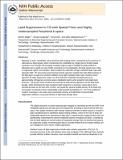| dc.contributor.author | Bilgic, Berkin | |
| dc.contributor.author | Gagoski, Borjan | |
| dc.contributor.author | Kok, Trina | |
| dc.contributor.author | Adalsteinsson, Elfar | |
| dc.date.accessioned | 2015-11-04T16:04:43Z | |
| dc.date.available | 2015-11-04T16:04:43Z | |
| dc.date.issued | 2012-07 | |
| dc.date.submitted | 2012-06 | |
| dc.identifier.issn | 07403194 | |
| dc.identifier.issn | 1522-2594 | |
| dc.identifier.uri | http://hdl.handle.net/1721.1/99707 | |
| dc.description.abstract | Mapping [superscript 1]H brain metabolites using chemical shift imaging is hampered by the presence of subcutaneous lipid signals, which contaminate the metabolites by ringing due to limited spatial resolution. Even though chemical shift imaging at spatial resolution high enough to mitigate the lipid artifacts is infeasible due to signal-to-noise constraints on the metabolites, the lipid signals have orders of magnitude of higher concentration, which enables the collection of high-resolution lipid maps with adequate signal-to-noise. The previously proposed dual-density approach exploits this high signal-to-noise property of the lipid layer to suppress truncation artifacts using high-resolution lipid maps. Another recent approach for lipid suppression makes use of the fact that metabolite and lipid spectra are approximately orthogonal, and seeks sparse metabolite spectra when projected onto lipid-basis functions. This work combines and extends the dual-density approach and the lipid-basis penalty, while estimating the high-resolution lipid image from 2-average k-space data to incur minimal increase on the scan time. Further, we exploit the spectral-spatial sparsity of the lipid ring and propose to estimate it from substantially undersampled (acceleration R = 10 in the peripheral k-space) 2-average in vivo data using compressed sensing and still obtain improved lipid suppression relative to using dual-density or lipid-basis penalty alone. | en_US |
| dc.description.sponsorship | National Institutes of Health (U.S.) (Grant NIH R01 EB007942) | en_US |
| dc.description.sponsorship | National Science Foundation (U.S.) (Grant 0643836) | en_US |
| dc.description.sponsorship | Siemens-MIT Alliance | en_US |
| dc.description.sponsorship | MIT-Center for Integration of Medicine and Innovative Technology (Medical Engineering Fellowship) | en_US |
| dc.language.iso | en_US | |
| dc.publisher | Wiley Blackwell | en_US |
| dc.relation.isversionof | http://dx.doi.org/10.1002/mrm.24399 | en_US |
| dc.rights | Creative Commons Attribution-Noncommercial-Share Alike | en_US |
| dc.rights.uri | http://creativecommons.org/licenses/by-nc-sa/4.0/ | en_US |
| dc.source | PMC | en_US |
| dc.title | Lipid suppression in CSI with spatial priors and highly undersampled peripheral k-space | en_US |
| dc.type | Article | en_US |
| dc.identifier.citation | Bilgic, Berkin, Borjan Gagoski, Trina Kok, and Elfar Adalsteinsson. “Lipid Suppression in CSI with Spatial Priors and Highly Undersampled Peripheral k-Space.” Magnetic Resonance in Medicine 69, no. 6 (July 17, 2012): 1501–1511. | en_US |
| dc.contributor.department | Harvard University--MIT Division of Health Sciences and Technology | en_US |
| dc.contributor.department | Massachusetts Institute of Technology. Department of Electrical Engineering and Computer Science | en_US |
| dc.contributor.mitauthor | Bilgic, Berkin | en_US |
| dc.contributor.mitauthor | Kok, Trina | en_US |
| dc.contributor.mitauthor | Adalsteinsson, Elfar | en_US |
| dc.relation.journal | Magnetic Resonance in Medicine | en_US |
| dc.eprint.version | Author's final manuscript | en_US |
| dc.type.uri | http://purl.org/eprint/type/JournalArticle | en_US |
| eprint.status | http://purl.org/eprint/status/PeerReviewed | en_US |
| dspace.orderedauthors | Bilgic, Berkin; Gagoski, Borjan; Kok, Trina; Adalsteinsson, Elfar | en_US |
| dc.identifier.orcid | https://orcid.org/0000-0002-7637-2914 | |
| mit.license | OPEN_ACCESS_POLICY | en_US |
| mit.metadata.status | Complete | |
